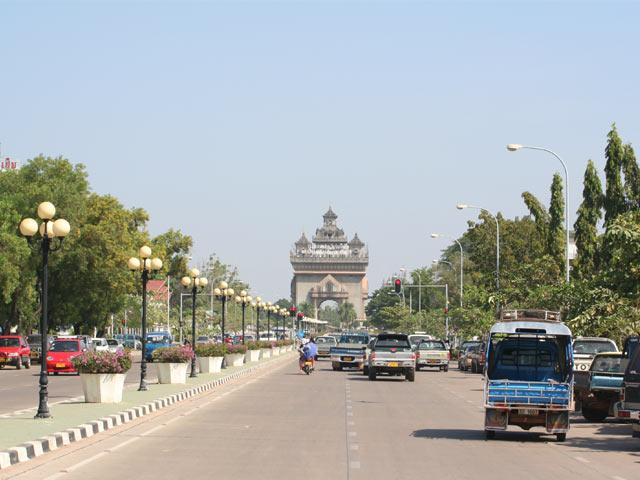You are here
Leak detection and loss reduction campaign

- Localization:Lao Vientiane
- Contract type:
- Type of service:
- Funder:Agence française de développement (AFD)
- Contract duration:2002, 6 months
Summary
The city of Vientiane is supplied by two treatment plants, raw water coming from the Mekong. At the beginning of the project, the length of the distribution network represented about 450km and there were 42000 water connections. Losses were at 30% of the volume produced. Production infrastructures were saturated and some areas were not supplied permanently. Due to this situation, it was considered urgent to launch a loss reduction project.
The objectives of this project were the following :
- To reduce the level of losses from 30% to 25% in one or several pilot areas;
- To set an action plan to reduce losses for the whole agglomeration of Vientiane over the next two year period;
- To train the staff on the loss reduction equipment and methods.
The Service:
The services lasted five months and included 4 phases:
- Phase 1 : setting up of the mission, preliminary assessment, launching of field surveys, production of the take over report.
- Phase 2 : field surveys, field and laboratory tests to complete and detail the preliminary assessment, procurement of specialised equipment, detailed definition of the actions of phase 3, production of the report on methodology;
- Phase 3 : actions to reduce losses in some pilot areas, use of the purchased specialised equipment;
- Phase 4 : critical analysis of the outputs, drawing up of the 2-year action plan for the reduction of losses, production of the final report.
Results of the loss reduction campaign :
- This campaign was performed between January and May 2002. The results can be classified in five categories :
- Better knowledge of the loss ratio of the water supply network,
- The effective reduction of the losses in the pilot areas;
- Better knowledge of the various components of the loss and of the means to reduce it;
- The training of the staff,
- The organisation of the management.
The detailed study and the assessment of the volumes produced and billed revealed that the initial loss ratio had been underestimated, being 34% instead of 30%.
The pilot areas where actions were implemented represented about 25% of the total network. The impact of the actions led to the reduction of losses from 34% to 31% during the four months of the pilot operation.
The results of the surveys "detection of leaks and anomalies on meters, repairing and monitoring" are the following :
- Number of leaks pet kilometre of pipe = 4,1
- Percentage of faults on the meters of customers = 9%
74% of the detected leaks and 61% of meters needing to be serviced have been repaired.
Customer surveys have been carried out on 1600 connections, with the following results:
- Faulty meters : 3%,
- Unreadable meters : 4%,
- Difficult access : 4%,
- Meters tampered with : 10%,
- Leak before meter : 6%,
- Frauds : only a few cases
Surveys were carried out on the 50 largest consumers. The main results are the following:
- The majority meters were not installed properly,
- A lot of meters were oversized,
- For the large administrative customers (ministries, universities, hospitals, etc.), the level of losses and wastage reached unacceptable levels (night consumption higher than day consumption).
Installed meters were tested with the bench of Nam Papa Lao (also formerly tested, which highlighted some necessary adjustments). The tests revealed some inaccuracies due to ageing and brands of meters and some recommendations have therefore been made to renew the existing stock. Tests on the accuracy of meters have also been made in the field, by the means of a portable bench.
Permanent recording of instantaneous flows (data logging) were made, over several days. They made it possible to highlight the fact that 25% of flows were under the transition flow, which generated a significant under-metering for some serviced meters.
Staff were trained in the use of equipment and interpretation of results : acoustic correlator, electromagnetic leak detector, detector of mass and non-metallic pipes, portable ultrasonic flow-meter, electromagnetic flow-meter, data loggers, class C volumetric meters, manometers.
The implementation of the programme of loss reduction required some improvements and the setting up of new procedures.
Two-year action plan:
The results of the actions performed during the project showed that it is possible to reach the settled objective set (25% of losses by the end of 2004) if some measures are taken, as follows:
- To reduce physical and commercial losses :
- Continuation of the visible leak detection and repairing campaign,
- Detection and repairing of invisible leaks,
- Implementation of district metering,
- Replacement or reinstallation of detective meters,
- Resizing of large consumption meters,
- Replacement of old meters,
- Replacement of old pipes,
- Reduction of leaks before meters of administrative customers;
To strengthen the institutional and organisational issues:
- Technical assistance,
- Creation of a Department to Improve Outputs, in charge of the detection and repairing of leaks, metering management, etc.,
- acquisition and installation of a new Customer management Programme,
- acquisition of operational material,
- continuation of the training programmes.
All these operations have been quantified. The cost of the Project has been estimated and a cost/benefit study has been carried out.
